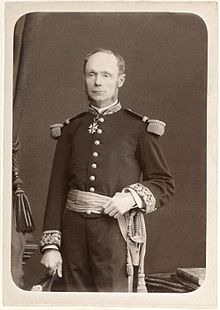French admiral. Born on 26 June 1827 at Abbeville (Pas-de-Calais), Amédée Courbet joined the navy following graduation from the École Polytechnique in 1849. His naval career was spent largely on foreign duty stations, with intervals as an instructor at the naval gunnery school (1860) and commandant at the torpedo testing school (1874). He moved fairly rapidly through the ranks, from ensign in 1852 to vice admiral in 1880.
Following a stint as governor of New Caledonia, Courbet became commander of the Far Eastern Fleet in 1883. It had just been reinforced following the death near Hanoi of Francis Garnier, who was killed while trying to turn Tonkin (northern Vietnam) into a French protectorate.
In August 1883 Courbet’s fleet breached the river defenses of the imperial capital of Hue and forced the government to accept a French protectorate over all of Vietnam. In succeeding months French troops began occupying Tonkin. Courbet initially took command of the land operations as well as those offshore, to the consternation of local French marine and army commanders.
The French invaders not only had to contend with Tonkinese opposition but also Chinese troops sent south to underscore China’s historic claim to overlordship over Vietnam (the Black Flag/Tonkin Wars, 1882–1885). Courbet persuaded Paris to carry the war to China, and in August 1884 he took a battle fleet up the Min River to attack the Chinese naval base at Fuzhou (Foo Chow). Within an hour all Chinese ships were either sunk or on fire and drifting. Two French torpedo boats scored a spectacular success in sinking the Chinese flagship and damaging another warship. Courbet’s fleet then shelled the naval arsenal. Subsequent attempts to establish French strongholds on Formosa and the Pescadores Islands between China and Vietnam (seen as a potential French Hong Kong) failed, but the admiral eventually succeeded in bringing the Chinese to the negotiating table by interdicting the rice trade between Formosa and China. The Chinese government then agreed to a French protectorate over Vietnam.
Courbet’s role as one of the chief architects of France’s conquest of Indochina and his role in the war with China made him a popular hero in France. Worn out by the long Asian campaign, however, Courbet died on board his flagship off Vietnam on 11 June 1885.
References
Chere, Lewis M. The Diplomacy of the Sino-French War (1883–1885): Global Complications of an Undeclared War. Notre Dame, IN: Cross Roads Books, 1988.
McAleavy, Henry. Black Flags in Vietnam: The Story of a Chinese Intervention: The Tonkin War of 1884–1885. New York: Macmillan, 1968.
Thomazi, A. La conquête de l’Indochine. Paris: Payot, 1934.
